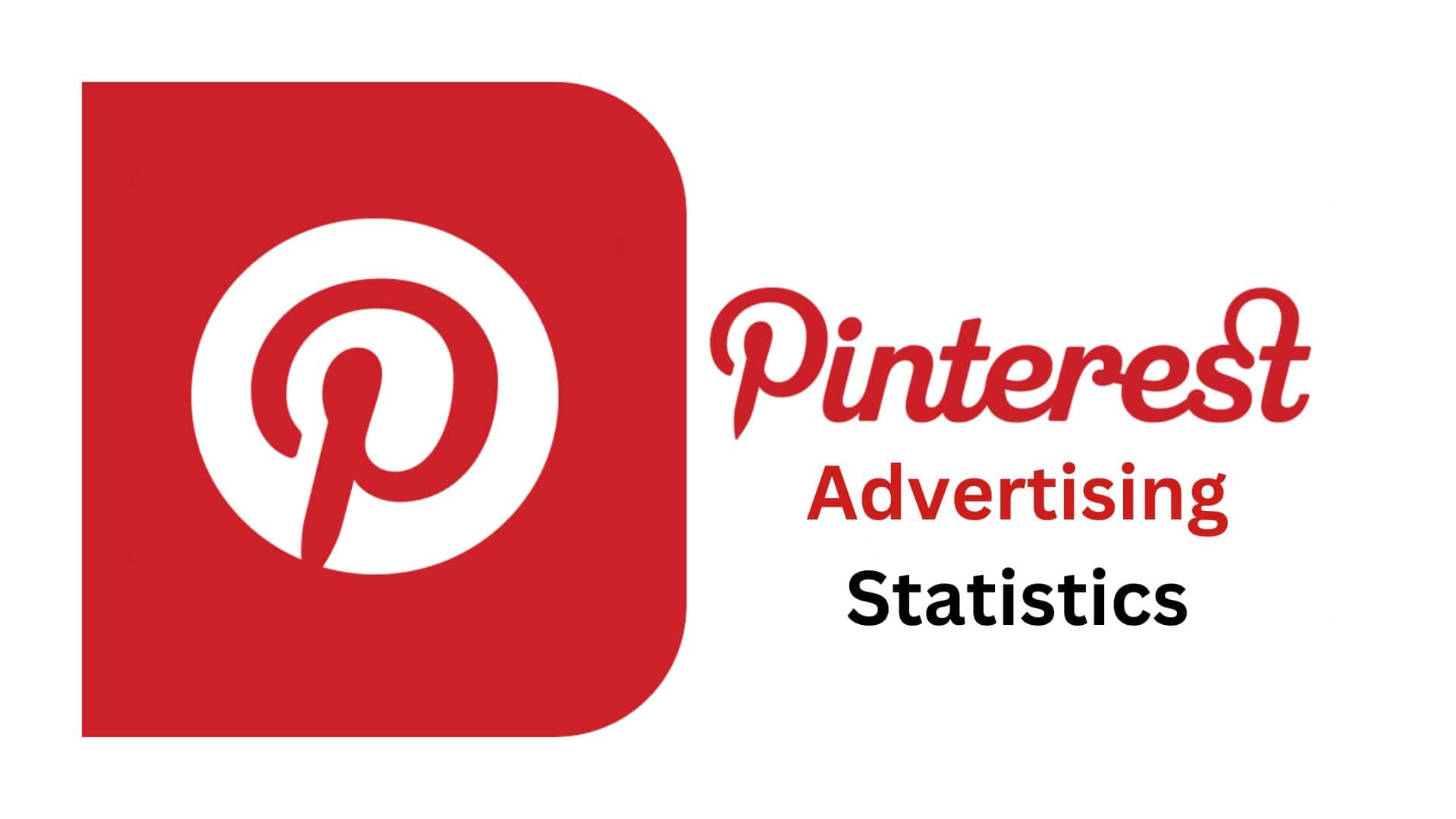Fedora Statistics By Users, Usage and Facts (2025)
Updated · Sep 22, 2025
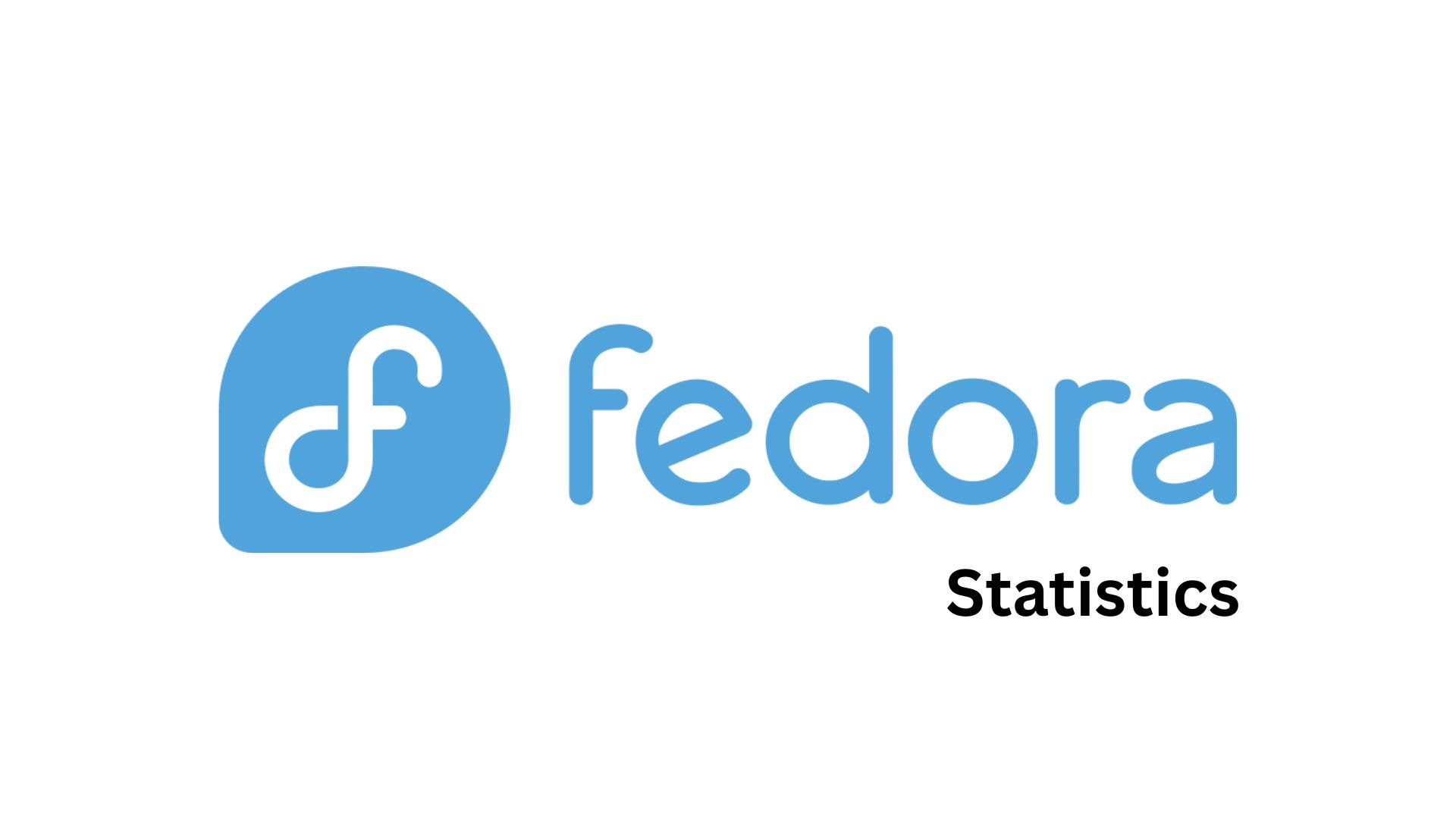
Table of Contents
- Introduction
- Editor’s Choice
- Basic Analyses About Fedora
- Federo Release Analyses
- Fedora Market Statistics
- Fedora Active Weekly Users Statistics
- Fedora Customers Statistics
- Fedora Website Usage Statistics
- Number of Fedora Websites Statistics By Country
- Fedora Translation Progress By Language
- Features of The Fedora
- Advantages And Disadvantages of Fedora
- Conclusion
Introduction
Fedora Statistics: Fedora Linux, created in 2003 as Red Hat Linux’s successor, is developed by the Fedora Project. It includes free and open-source software and focuses on modern technologies. Today, it serves as the upstream source for CentOS Stream and Red Hat Enterprise Linux. Fedora Linux is a widely used community-based distribution, known for bringing new ideas, strong security, and regular updates. Over time, it has gained a large number of users around the world.
Statistics about Fedora show its growth, adoption patterns, release performance, and role in the Linux ecosystem. These details help explain not only Fedora’s importance in the open-source community but also how it shapes enterprise systems such as Red Hat Enterprise Linux and CentOS Stream.
Editor’s Choice
- According to the 6sense report analysis, Fedora currently serves around 4,317 customers, giving it an estimated market share of 0.31%.
- As per Wikipedia, the recent Fedora releases include Fedora 40 on April 23, 2024, Fedora 41 on October 29, 2024, and Fedora 42 on April 15, 2025.
- The active user in Fedora is the Workstation edition, which leads with around 192.8k active users, followed by Server at 62.0k and KDE at 51.7k.
- In 2025, more than 4,317 companies worldwide began using Fedora as their server and desktop operating system.
- The leading country using Fedora for servers and desktops is the United States, with 1,693 customers (52.73%).
- Fedora website usage statistics state that among the top one million websites, 742 use Fedora, while 156 are within the top 100,000 and 18 appear in the top 10,000.
- A report published by trends.builtwith.com, the United States leads with the highest number of users at 14,172, followed by Germany with 1,153 and the United Kingdom with 689.
Basic Analyses About Fedora
| Metrics | Detailed Analysis |
| First Release | November 4, 2003 |
| Latest Release | Version 42 “Adams” – released on April 15, 2025 |
| Developer | Fedora Project |
| OS Family | Unix-like |
| Status | Actively maintained |
| Model | Open-source |
| Repository | src.fedoraproject.org |
| Target Users | Desktop users, servers, and supercomputers |
| Package Manager | RPM with DNF, Flatpak, and OSTree |
| Main Platforms | x86-64, armhf, AArch64 |
| Other Platforms | mips64el, mipsel, ppc64le, RISC-V, s390x |
| Kernel Type | Monolithic (Linux kernel) |
| Userland | GNU |
| Default Interfaces | GNOME Shell, KDE Plasma 6 |
| Licensing | GPL and other free software licenses, plus some proprietary firmware |
| Official Website | fedoraproject.org |
Federo Release Analyses
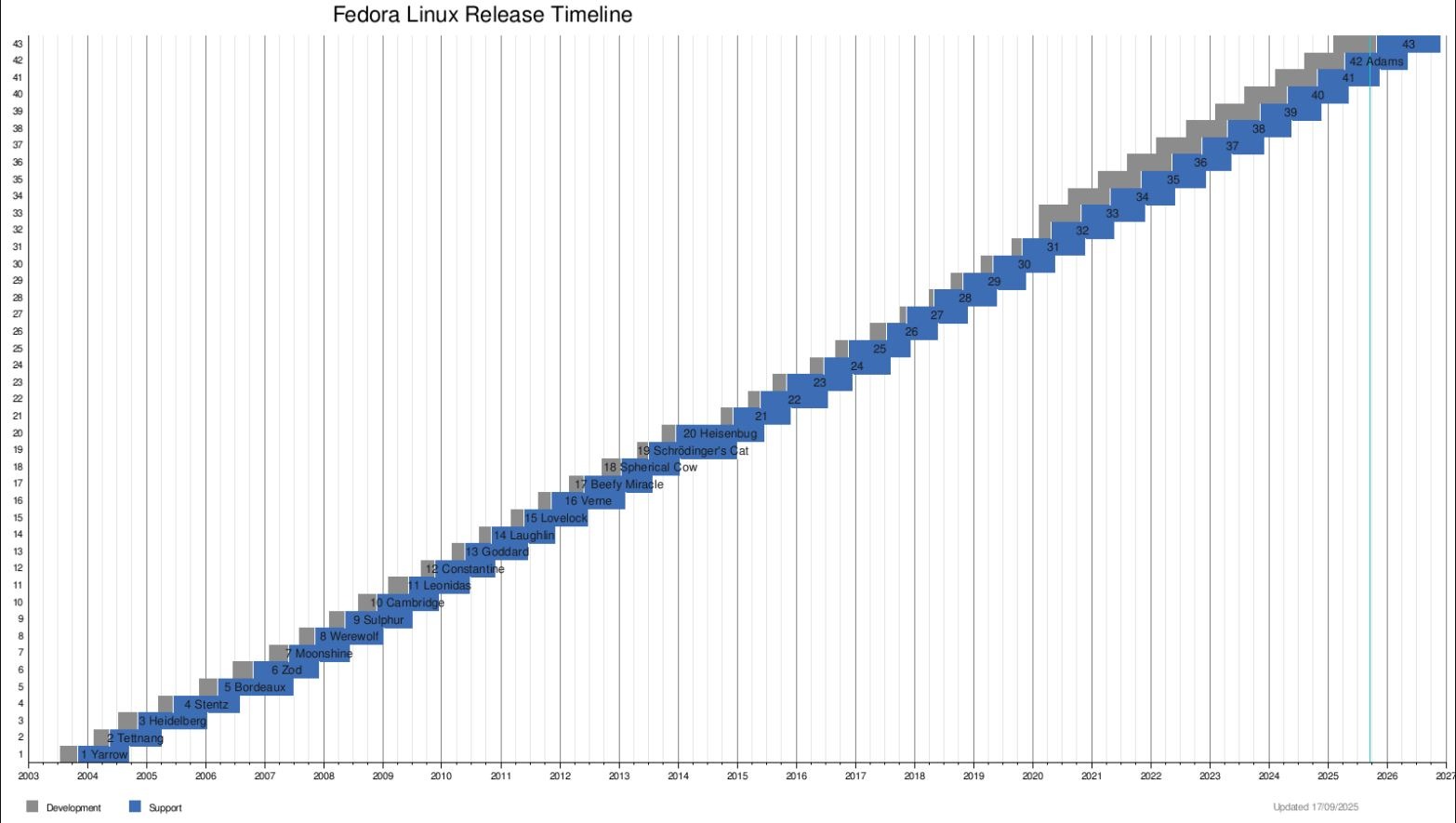
(Source: upload.wikimedia.org)
| Release Date | Version (Codename) | GNOME | Kernel |
| 2026-04-14 | 44 | To be determined | |
| 2025-11-11 | 43 | 49 | To be determined |
| 2025-04-15 | 42 (Adams) | 48 | 6.14 |
| 2024-10-29 | 41 | 47 | 6.11 |
| 2024-04-23 | 40 | 46 | 6.8 |
| 2023-11-07 | 39 | 45 | 6.5 |
| 2023-04-18 | 38 | 44 | 6.2 |
| 2022-11-15 | 37 | 43 | 6 |
| 2022-05-10 | 36 | 42 | 5.17 |
| 2021-11-02 | 35 | 41 | 5.14 |
| 2021-04-27 | 34 | 40 | 5.11 |
| 2020-10-27 | 33 | 3.38 | 5.8 |
| 2020-04-28 | 32 | 3.36 | 5.6 |
| 2019-10-29 | 31 | 3.34 | 5.3 |
| 2019-04-30 | 30 | 3.32 | 5 |
| 2018-10-30 | 29 | 3.3 | 4.18 |
| 2018-05-01 | 28 | 3.28 | 4.16 |
| 2017-11-14 | 27 | 3.26 | 4.13 |
| 2017-07-11 | 26 | 3.24 | 4.11 |
| 2016-11-22 | 25 | 3.22 | 4.8 |
| 2016-06-21 | 24 | 3.2 | 4.5 |
| 2015-11-03 | 23 | 3.18 | 4.2 |
| 2015-05-26 | 22 | 3.16 | 4 |
| 2014-12-09 | 21 | 3.14 | 3.17 |
| 2013-12-17 | 20 (Heisenbug) | 3.1 | 3.11 |
| 2013-07-02 | 19 (Schrödinger’s Cat) | 3.8 | 3.9 |
| 2013-01-15 | 18 (Spherical Cow) | 3.6 | 3.6 |
| 2012-05-29 | 17 (Beefy Miracle) | 3.4 | 3.3 |
| 2011-11-08 | 16 (Verne) | 3.2 | 3.1 |
| 2011-05-24 | 15 (Lovelock) | 3 | 2.6.38 |
| 2010-11-02 | 14 (Laughlin) | 2.32 | 2.6.35 |
| 2010-05-25 | 13 (Goddard) | 2.3 | 2.6.33 |
| 2009-11-17 | 12 (Constantine) | 2.28 | 2.6.31 |
| 2009-06-09 | 11 (Leonidas) | 2.26 | 2.6.29 |
| 2008-11-25 | 10 (Cambridge) | 2.24 | 2.6.27 |
| 2008-05-13 | 9 (Sulphur) | 2.22 | 2.6.25 |
| 2007-11-08 | 8 (Werewolf) | 2.2 | 2.6.23 |
| 2007-05-31 | 7 (Moonshine) | 2.18 | 2.6.21 |
| 2006-10-24 | 6 (Zod) | 2.16 | 2.6.18 |
| 2006-03-20 | 5 (Bordeaux) | 2.14 | 2.6.15 |
| 2005-06-13 | 4 (Stentz) | 2.1 | 2.6.11 |
| 2004-11-08 | 3 (Heidelberg) | 2.8 | 2.6.9 |
| 2004-05-18 | 2 (Tettnang) | 2.6 | 2.6.5 |
| 2003-11-05 | 1 (Yarrow) | 2.4 | 2.4.22 |
Fedora Market Statistics
- According to the 6sense report analysis, Fedora currently serves around 4,317 customers, giving it an estimated market share of 0.31%.
- Besides being widely respected in the Linux community, Fedora holds the #35 position in the global ranking.
- In the Server and Desktop OS category, Fedora’s biggest competitors are Oracle Linux with 14.52%, Linux with 14.50%, and Apple iOS with 10.16% market share.
The image below describes the market position of Fedora as of September 17, 2025

(Source: w3techs.com)
Fedora Active Weekly Users Statistics
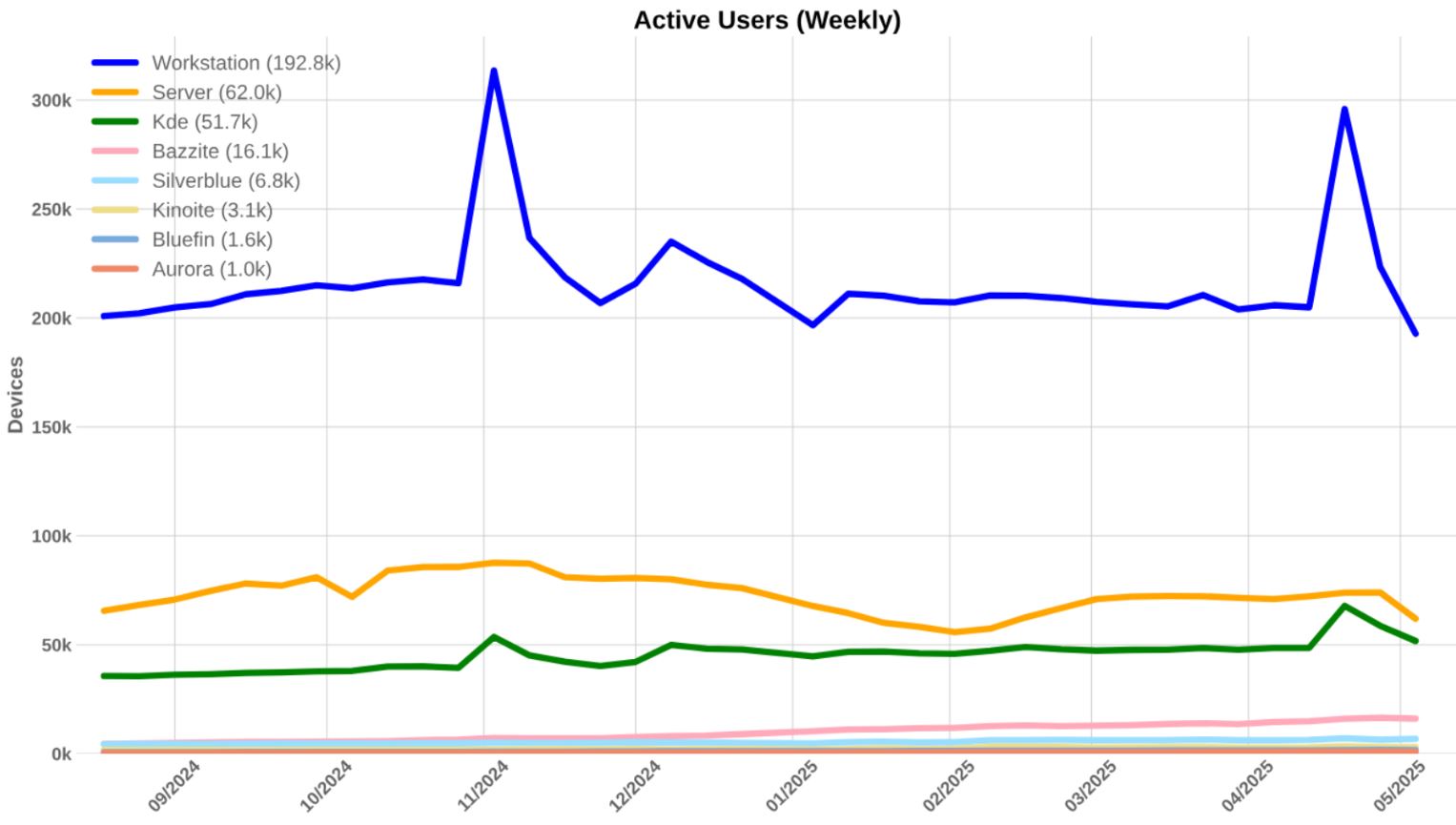
(Source: us1.discourse-cdn.com)
- The Workstation edition leads with around 192.8k active users, followed by Server at 62.0k and KDE at 51.7k.
- Other editions like Bazzite (16.1k), Silverblue (6.8k), Kinoite (3.1k), Bluefin (1.6k), and Aurora (1.0k) have smaller but steady user counts.
Fedora Customers Statistics
- In 2025, more than 4,317 companies worldwide began using Fedora as their server and desktop operating system, as mentioned in a report published by 6sense.com.
- Companies such as NEC Corporation in Japan, Vestel in Turkey, and Toll Group in Australia each have more than 10,000 employees and use Fedora for their operations.
- In the United States, major organisations like Contractor, Verizon Connect, Jabil, Discover Financial Services, Motorola Solutions, and the U.S. Department of Defence also rely on Fedora, all with employee counts exceeding 10,000.
By Products And Services
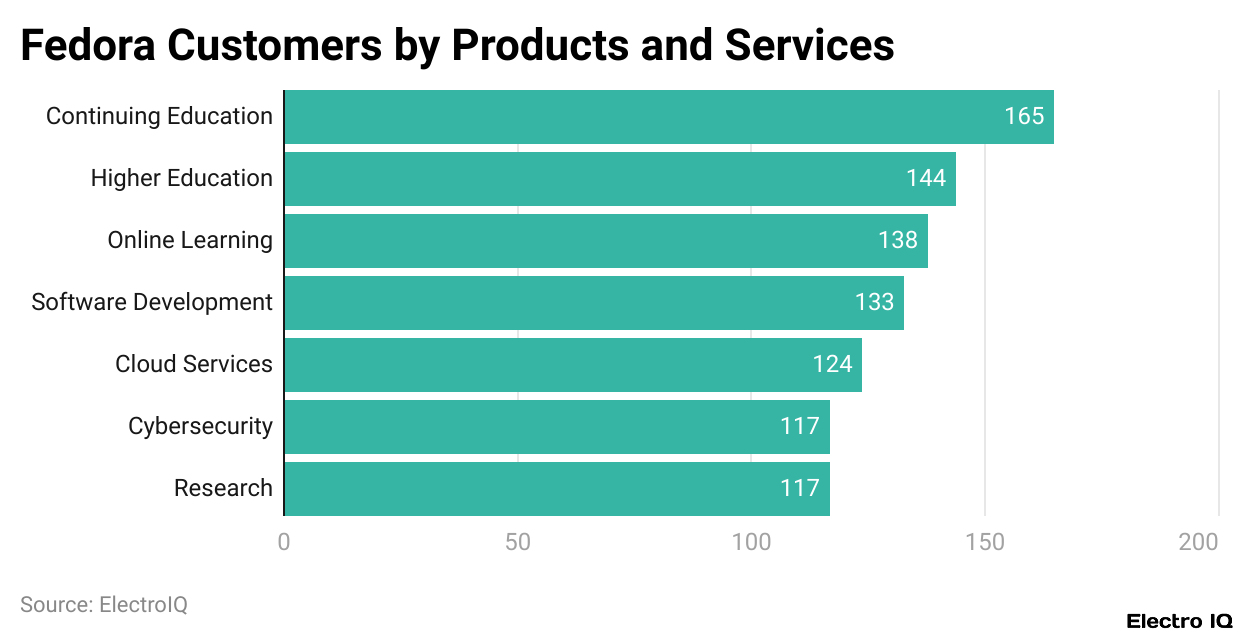
(Reference: 6sense.com)
- As of 2025, the most popular services among Fedora users for server and desktop use are Continuing Education with 165 users, Higher Education with 144 users, and Online Learning with 138 users.
- Furthermore, other customers in different segments are followed as Software Development (133), Cloud Services (124), Cybersecurity (117), and Research (117).
By Employee Size
- Most of Fedora’s customers in the server and desktop OS category are medium to large businesses, including 789 companies with 100 to 249 employees, 701 companies with 1,000 to 4,999 employees, and 672 companies with 20 to 49 employees.
- Other Fedora customers are followed by 659 companies with 10,000+ employees, and 444 companies with 250 to 499 employees.
By Country
- The leading countries using Fedora for servers and desktops are the United States with 1,693 customers (52.73%), followed by India with 443 customers (13.80%), and Brazil with 225 customers (7.01%).
- Meanwhile, other countries’ customer counts are followed by the United Kingdom (202), Canada (167), France (150), and Spain (102).
Fedora Website Usage Statistics
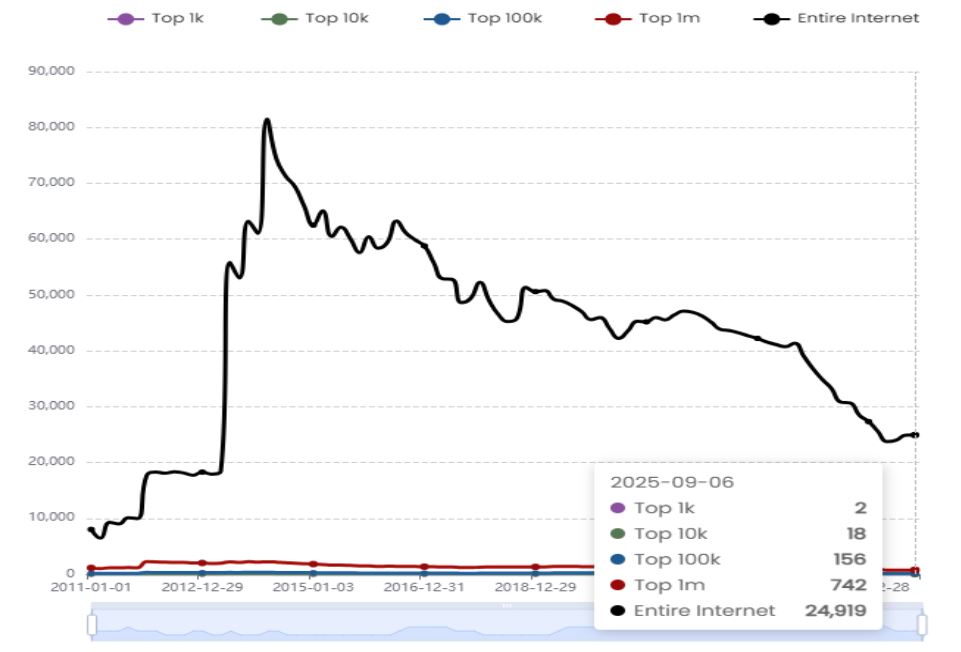
(Source: trends.builtwith.com)
- Fedora website usage statistics state that among the top one million websites, 742 use Fedora, while 156 are within the top 100,000, and 18 appear in the top 10,000.
- Meanwhile, outside the top one million, 23,879 websites are using Fedora.
- In terms of technology spending, 7,145 websites spend over USD 100, 6,146 spend more than USD 500, 5,801 spend above USD 1,000, 760 spend over USD 5,000, and 186 invest beyond USD 10,000.
- Social media following is also notable, with 1,685 accounts having over 10 followers, 1,495 crossing 100, 1,186 exceeding 500, 989 surpassing 1,000, 541 with more than 5,000, 386 over 10,000, 90 above 100,000, and 11 having over 1 million followers.
- Sales revenue distribution shows 1,304 earning above USD 100, 1,278 above USD 500, 1,258 above USD 1,000, 1,164 over USD 5,000, 1,005 more than USD 10,000, 221 above USD 100,000, and 34 generating over USD 1 million.
- Product offerings also vary, with 388 websites listing more than 10 products, 124 above 50, 25 over 100, and 46 showcasing more than 500 products.
Number of Fedora Websites Statistics By Country
- A report published by trends.builtwith.com, the United States leads with the highest number of users at 14,172, followed by Germany with 1,153 and the United Kingdom with 689.
- France has 506 users, while the Czech Republic reports 415, Canada 392, and Austria 371.
- Poland has 363 users, followed by Russia (320), Australia (278), the Netherlands (262), Spain (245), Italy (239), Japan (235), Taiwan (233), Romania (230), Switzerland and the European Union (229 each), Brazil (213), Sweden (191), Denmark (172), Hungary (160), Ukraine (152), Hong Kong (151), India (146), and Mexico with 122 users.
Fedora Translation Progress By Language
| Language Code | Components | Pages | Words Progress |
| ar | 5 | 882 | 0.41% |
| ast | 18 | – | |
| az | 2 | 27 | – |
| be | 2 | 85 | 0.10% |
| bg | 2 | 54 | – |
| bn | 2 | 85 | 0.02% |
| ca | 6 | 1168 | 0.37% |
| cs | 16 | 1670 | 1.44% |
| de | 10 | 1524 | 1% |
| el | 9 | 1009 | 1.16% |
| es | 38 | 2173 | 24.21% |
| es_419 | 2 | 80 | 0.01% |
| fa | 6 | 131 | – |
| fi | 9 | 806 | 4.19% |
| fil | 3 | 45 | 0.01% |
| fr | 46 | 3059 | 4.25% |
| fur | 4 | 1099 | 0.68% |
| ga | 1 | 2 | 0.01% |
| he | 1 | 18 | – |
| hi | 4 | 632 | 0.66% |
| hr | 2 | 497 | 0.01% |
| hu | 3 | 110 | 0.01% |
| hy | 1 | 18 | – |
| id | 13 | 1361 | 13.04% |
| it | 19 | 1732 | 15.74% |
| ja | 9 | 1545 | 0.65% |
| ka | 1 | 83 | 0.38% |
| kab | 6 | 1077 | 0.01% |
| km | 1 | 83 | – |
| ko | 15 | 1553 | 7.77% |
| lt | 1 | 18 | 0.06% |
| mr | 2 | 94 | 0.01% |
| ms | 1 | 25 | – |
| my | 1 | 18 | – |
| nb_NO | 1 | 2 | – |
| ne | 1 | 2 | – |
| nl | 7 | 1142 | 0.89% |
| nn | 4 | 407 | 0.19% |
| or | 3 | 45 | 0.01% |
| pl | 5 | 627 | 1.06% |
| pt | 5 | 132 | 0.23% |
| pt_BR | 24 | 1839 | 11.69% |
| pt_PT | 9 | 844 | 0.08% |
| ro | 2 | 20 | – |
| ru | 7 | 1141 | 0.28% |
| si | 7 | 766 | 0.02% |
| sk | 1 | 18 | – |
| sq | 1 | 25 | – |
| sv | 5 | 173 | 0.33% |
| sw | 4 | 678 | 0.06% |
| te | 4 | 322 | – |
| tr | 13 | 1294 | 10.08% |
| tzm | 1 | 2 | – |
| uk | 15 | 1415 | 5.25% |
| ur | 1 | 495 | – |
| ur_PK | 4 | 1090 | 0.01% |
| uz | 1 | 2 | 0.01% |
| zh_CN | 7 | 733 | 1.63% |
| zh_Hans | 13 | 1625 | 3.60% |
| zh_Hant | 10 | 1222 | 0.09% |
| zh_TW | 3 | 30 | 0.12% |
Features of The Fedora
- Fedora is a popular Linux operating system known for its mostly stock GNOME desktop, which gives users a familiar and clean interface with some useful extra features.
- It is very easy to use, making it a reliable choice with a secure and powerful OS.
- Fedora provides the latest software with updates every six months, keeping users on the cutting edge.
- It is highly flexible, especially Fedora Server, offering full control over infrastructure and services.
- The OS is open-source, lightweight, and supports multiple architectures.
- It comes with pre-installed apps and uses RPM package management for software installation, including Delta RPM for updates.
Advantages And Disadvantages of Fedora
| Advantages | Disadvantages |
|
|
Conclusion
After completing the article on Fedora Statistics, Linux remains a trusted and forward-looking distribution in the open-source community. By focusing on new technologies, security, and frequent updates, it has steadily grown and gained the confidence of developers, businesses, and regular users.
Data on its usage and performance shows that Fedora not only supports a large global community but also plays an important role in the development of enterprise systems such as Red Hat Enterprise Linux and CentOS Stream. In summary, Fedora’s steady growth highlights its long-term value for both community projects and enterprise solutions.
FAQ.
Fedora Linux versions are supported for about 13 months, ending one month after the version X+2 release, with six-month gaps.
Fedora feels smoother for developers with cutting-edge tools, while Ubuntu offers easier usability for beginners.
Fedora is an upstream Linux distribution, providing innovations later adopted by Red Hat Enterprise Linux.
Fedora Linux is best for developers, open-source enthusiasts, and users wanting innovation with strong security.
Fedora mainly uses the EXT4 file system by default, but also supports Btrfs and XFS.

I hold an MBA in Finance and Marketing, bringing a unique blend of business acumen and creative communication skills. With experience as a content in crafting statistical and research-backed content across multiple domains, including education, technology, product reviews, and company website analytics, I specialize in producing engaging, informative, and SEO-optimized content tailored to diverse audiences. My work bridges technical accuracy with compelling storytelling, helping brands educate, inform, and connect with their target markets.









